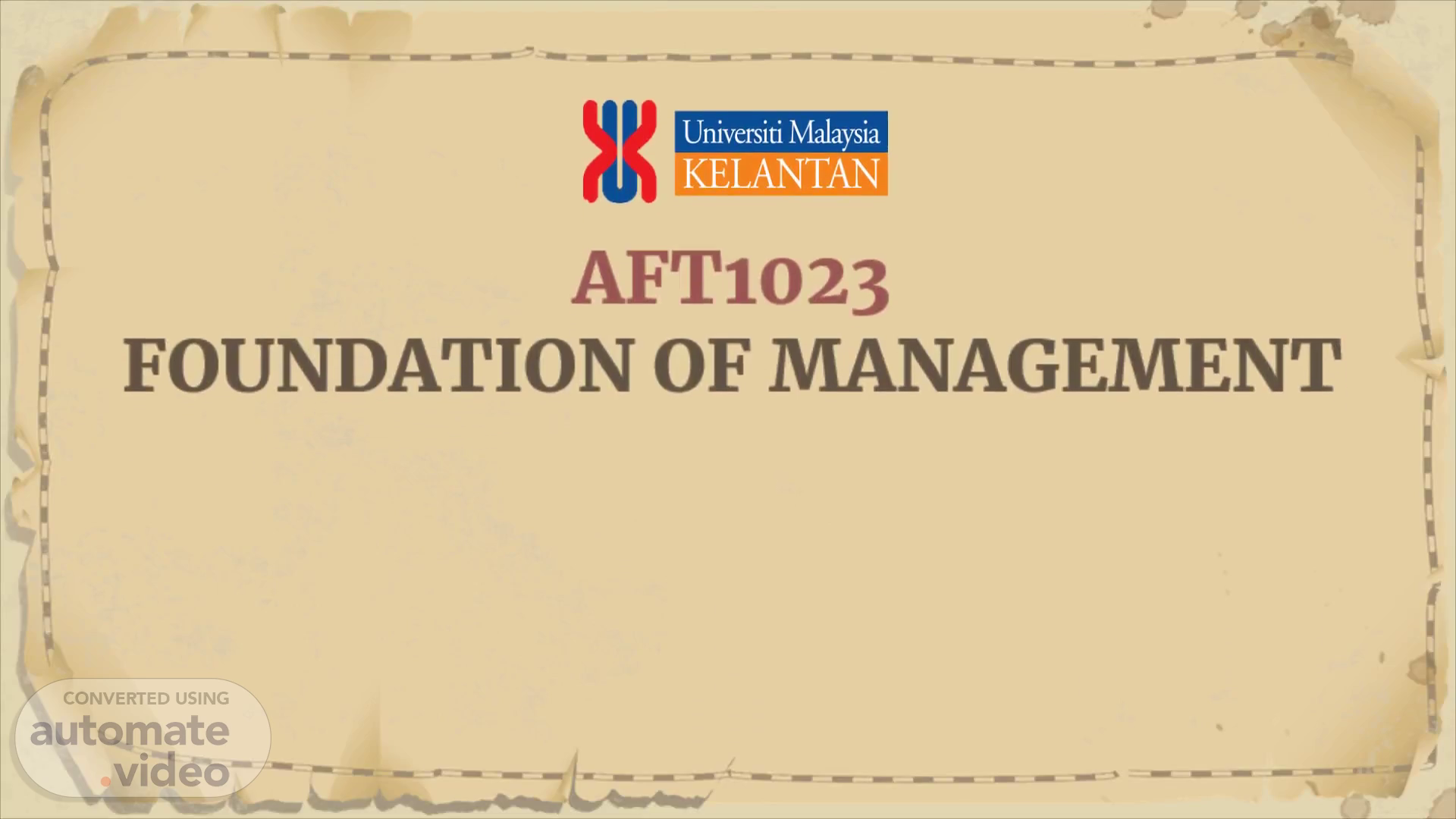
Page 1 (0s)
niversiti Malaysia. AFT1023 FOUNDATION OF MANAGEMENT.
Page 2 (15s)
FREDERICK WINSLOW. This section will be presented by : Najwa Najihah binti Abdul Amit (A21B3340).
Page 3 (26s)
abstract. FREDERICK WINSLOW TAYLOR. (1856-1915) was born in Germantown, Philadelphia, Pennsylvania and he was an American engineer..
Page 4 (45s)
VIEWPOINT ABOUT THE APPROACH. Assign a particular job based on skills and abilities Pay extra wages for employees that work overtime Do monitoring employees performance and behavior Assign positions according to their education level.
Page 5 (1m 10s)
ADVANTAGES AND DISADVANTAGES. Quick decision making Less production time Increase productivity Reduce inaccuracies Increase efficiency Increase production Provide a good workforce.
Page 6 (1m 27s)
CONCLUSION. The Scientific Management approach by Frederick Taylor brings many benefits to management to this day. All current business now has management and worker structures, and competition is managed by other outside aspects the boundaries of scientific management. Current businesses also priorities social factors including worker initiative, loyalty, and flexibility..
Page 7 (1m 44s)
This section will be presented by : Najwa Najihah binti Abdul Amit (A21B3340).
Page 8 (1m 56s)
. HENRY LAURENCE GANTT. (1861-1919) was born in Calvert County, Maryland, United States and he was a teacher and draftsman.
Page 9 (2m 11s)
VIEWPOINT ABOUT THE APPROACH. Uses of Gantt Chart Attract and retain a productive workforce will invests in giving pay, benefits, job opportunities, social opportunities, status and recognition while every employee that wants work and fair compensation will invests their time, effort, knowledge, skills and creativity.
Page 10 (2m 42s)
ADVANTAGES AND DISADVANTAGES. Visualize project information clearly Make project planning practical and realistic Avoid the delays and losses of money Boosts productivity Also a good communication tool.
Page 11 (2m 59s)
CONCLUSION. The Gantt Charts is an essential tool of management and a very successful and well-known organizational management tool. It has been adopted until now because it is beneficial to plan, organize, save labor force, cost and time. With the convenience of modern technology nowadays, it is easier because project management software can facilitate doing Gantt Charts for a large project or any management..
Page 12 (3m 20s)
HENRI FAYOL. This section will be presented by :.
Page 13 (3m 30s)
abstract. HENRI FAYOL. (1841-1925) was born in Istanbul, Turkey and he was a French mining engineer, mining executive, author and director of mines..
Page 14 (3m 55s)
VIEWPOINT ABOUT THE APPROACH. That approach is still used today to be applied but with certain changes in modern times. This is due to fact that approaches remain at the core of modern management. The many of the approaches used in today’s context are simpler than those used by Fayol, but the content is very similar..
Page 15 (4m 25s)
Principle: Division Of Labor. The division of labor should be divided between all that can and should not be concentrated on a handful of people or given work to the same person only. Principle: Discipline A disciplined workforce is essential to improve the quality and quantity of production by controlling the management process.
Page 16 (4m 42s)
ADVANTAGES AND DISADVANTAGES. Facilitates organizational structure Promotes the team concept.
Page 17 (4m 52s)
CONCLUSION. The classical management theory of Henri Fayol has a wide range of applications in today's industry. This is because some of Fayol's principles of management are applicable to the management of organizations. Despite its widespread acceptance, this idea has been criticized because it is based on Henri Fayol's personal experience while working at a coal mining factory. Finally, Fayol's fourteen principles and five functions continue to be incredibly useful as a strong foundation for every subsequent study on the issue, and without them, no modern manager would have had a sufficient starting point from which to develop their theory..
Page 18 (5m 19s)
MARY PARKER FOLLET. This section will be presented by :.
Page 19 (5m 29s)
. MARY PARKER FOLLET. (1868-1933) was born in Quincy, Massachusetts and she was an American social worker, management consultant, philosopher and pioneer in the fields of organizational theory and organizational behavior..
Page 20 (5m 46s)
VIEWPOINT ABOUT THE APPROACH. (VIEWPOINT).
Page 21 (5m 53s)
(EXAMPLES). RELATED EXAMPLES.
Page 22 (5m 59s)
ADVANTAGES AND DISADVANTAGES. (advantage). (disadvantage).
Page 23 (6m 6s)
CONCLUSION. (conclusion).
Page 24 (6m 13s)
MAX WABER. This section will be presented by : Hammam Batrisyia Uzma Binti Ramlan (A21A3256).
Page 25 (6m 24s)
. MAXIMILIAN KARL EMIL WEBER. (1864-1920) was born in Erfurt, Prussia, Germany and he was a German sociologist, historian, jurist, and political economist..
Page 26 (6m 45s)
VIEWPOINT ABOUT THE APPROACH. Bureaucratic Theory of management was developed by Max Weber in the 1800s. He argued that an organization must have a formal structure and clear rules, regulations and lines of authority. Public sector bureaucracies include many parts of goverment administration, the military and almost all the universities..
Page 27 (7m 2s)
Bureaucratic Theory of Organisation describes how individuals are formed and fit within an organisation . Employees' salaries are totally reliant on their position since they are paid for their services, which are split by job position. The atmosphere is cold and impersonal, and all employee connections are strictly professional. Managers should keep meticulous records on every position, incidence, or problem that impacts the firm. Weber recommended that only the most perfect individuals with the specific skill set necessary for the role be employed. Duties should be allocated based on skill and ability, rather than relationships or personality traits..
Page 28 (7m 30s)
ADVANTAGES AND DISADVANTAGES. (Advantage) Efficiency Predictability Division of labour Administration duties are carried out..
Page 29 (7m 43s)
CONCLUSION. In a bureaucratic system, getting things done is expensive because it depends on the old conventional form of administration rather than contemporary ways. As a result, every annual budget must include material costs for papers, printers, ink, and computers, all of which are discarded after a certain amount of time..
Page 30 (8m 1s)
THANK YOU.